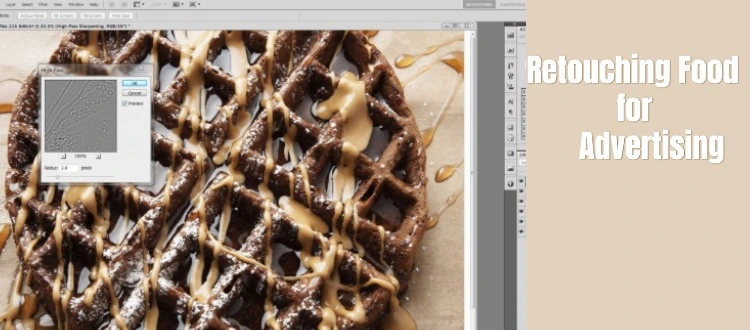Theodore Lowe, Ap #867-859
Sit Rd, Azusa New York
Find us here
Retouching Food for Advertising: Achieving Perfect Realism

You might even find your mouth watering. But have you ever wondered how these images look so perfect? The secret lies in the art of food retouching for advertising, where balancing perfection and realism is key. As a consumer, you want to see food that looks appetizing and real, not something that feels unattainable or overly artificial.
This is where the challenge arises for photographers and retouchers. They must walk the fine line between enhancing the appeal of food and keeping it authentic. How do they achieve this delicate balance? And why is it crucial for capturing your interest and trust? You’ll discover the intriguing world of food retouching. You’ll learn about the techniques used to enhance images while maintaining their allure. More importantly, you’ll understand why this balance matters to you as a viewer and a consumer. Dive in and see how the magic happens behind those irresistible images that make you crave more.
Importance Of Food Retouching
Food retouching plays a crucial role in food advertising. It enhances the visual appeal of food images. This process involves adjusting colors, textures, and details. The aim? To make food items look more appealing and appetizing. Balancing perfection and realism is key. Consumers are drawn to visually appealing food. Yet, they want it to look real. Let's delve deeper into why food retouching is important.
Influence On Consumer Perception
First impressions matter. In food advertising, the first impression is visual. A well-retouched food image can create a craving. People often judge food by its appearance. Attractive images entice consumers to buy. They associate vibrant images with quality and taste. Retouching helps create these appealing images. It can influence consumer choices and perceptions. The right balance can make food look both perfect and real. This builds trust with the consumer.
Role In Marketing Strategies
Food retouching is vital in marketing strategies. It sets a brand apart from competitors. A visually appealing image can make a brand memorable. Companies often use retouched images in advertisements. This attracts more attention and interest. It can drive higher engagement rates. Retouching also helps maintain brand consistency. Consistent imagery strengthens brand identity. It ensures that the brand is easily recognizable. Well-retouched images can elevate a brand’s market presence.
Techniques For Enhancing Food Imagery
Retouching food images for advertising is an art. It's about finding the sweet spot between perfection and realism. The goal is to make the food look irresistible. But also believable. This requires skillful techniques to enhance the imagery without losing authenticity. Let's explore these techniques.
Color Correction And Enhancement
Color plays a key role in food photography. Bright colors make food look fresh and appetizing. Adjusting hues can bring out the best in food. Use software tools to correct any color imbalances. Enhance the saturation to make the colors pop. But keep it natural. Overdoing it can make the food look fake.
Texture And Detail Accentuations
Texture adds depth to food imagery. It's crucial for making the food seem tangible. Highlight textures to showcase the food's appeal. Sharpening tools can bring out details like the crispness of a salad. Or the juiciness of a steak. These details make the viewer almost taste the dish. But balance is key. Too much texture can distract from the main subject.
Lighting And Shadows Adjustments
Lighting sets the mood for food photography. Proper lighting makes food look inviting. Use soft light to highlight the food's best features. Adjust shadows to add dimension. This creates a sense of realism. Shadows can make the food appear more three-dimensional. But be careful. Harsh lighting can make food look unappealing.
Tools Of The Trade
Food retouching tools enhance appeal while maintaining authenticity. Experts balance colors, textures, and lighting for realistic advertising. Achieving perfection without sacrificing realism captivates audiences and boosts engagement.
Food retouching in advertising demands precision and creativity. The right tools can make a significant difference. Achieving balance between perfection and realism requires choosing the right software and hardware. Let's delve into what professionals use to create visually appealing food images.
Software And Applications
Photo editing software is essential for food retouching. Adobe Photoshop is the industry standard. It offers powerful features for enhancing images. From color correction to texture adjustments, Photoshop provides versatility. Lightroom complements Photoshop with its intuitive interface. It excels in managing and editing large batches of photos. Capture One is another favorite among photographers. It offers advanced color grading tools. Each software has unique features that cater to specific needs. Choosing the right one depends on the project's requirements.
Hardware Considerations
Quality hardware supports efficient retouching. A high-resolution monitor is crucial. It ensures accurate color display. Look for monitors with good color calibration features. Graphics tablets are popular among retouchers. They provide precise control over edits. Wacom tablets are widely used. They offer various pressure sensitivity levels. A powerful computer enhances workflow speed. It allows seamless multitasking with heavy software. Good hardware ensures smooth operation and detailed retouching. Reliable tools lead to high-quality food images.
Challenges In Achieving Realism
Retouching food for advertising demands a delicate balance. The goal is to make food look both perfect and realistic. This can be tricky. Too much perfection makes the food look fake. On the other hand, showing too much reality might not be appealing. This creates a challenge in achieving realism. Advertisers need to craft images that are both enticing and believable.
Balancing Perfection And Authenticity
Advertisers often face the struggle of making food look perfect. They use techniques like adding gloss or enhancing colors. But these methods can make food look unreal. Real food has slight imperfections. A sprinkle of crumbs or a drip of sauce adds authenticity. These imperfections can make the food more relatable. Finding the right balance is key.
Authenticity also builds trust with viewers. People want to see what they will actually eat. They appreciate seeing food that looks like what they would find in a store. This connection can boost the success of an ad campaign.
Maintaining Consistency Across Campaigns
Consistency is crucial in advertising. Brands often run multiple campaigns. Each campaign must deliver a similar look and feel. This ensures that the brand message is clear and unified. Consistent imagery helps build brand recognition.
Maintaining consistency involves using similar retouching techniques. These techniques should align with the brand's style. A cohesive style makes campaigns more effective. It also helps the audience recognize the brand quickly.
Consistency does not mean boring. It means creating a reliable image that audiences trust. This approach can strengthen the brand's identity and message.
Ethical Considerations
Food advertising often presents mouth-watering images that make you crave what you see, but have you ever wondered how authentic these images are? Retouching food photos is a common practice in advertising to make products look their best. However, this raises ethical questions about the balance between perfection and realism. As a consumer, knowing the truth behind these images can impact your trust in brands. Let’s delve into the ethical considerations you should be aware of.
Truthfulness In Advertising
When you see a glossy burger on a billboard, you expect it to look the same when you order it. But often, advertising photos are retouched to enhance colors and textures. This practice can distort reality, making the food appear fresher and more appealing than it actually is.
Ethical advertising should aim to present products honestly. Misleading images not only deceive you but also violate advertising standards. It’s crucial for brands to strike a balance between making food look enticing and staying true to its actual appearance.
Think about the last time you felt disappointed by a meal that didn’t match its picture. Would you trust that brand again? This is the dilemma brands face when considering truthfulness in advertising.
Impact On Consumer Trust
Trust is the foundation of any relationship, including the one between you and your favorite food brands. If a brand consistently delivers products that look different from their advertisements, you might question its integrity.
Advertising should build trust, not break it. Brands that prioritize ethical retouching maintain consumer trust and loyalty. Remember, it’s not just about the immediate sale; it’s about creating a lasting relationship.
Consider how you feel when a brand surprises you with a product that exceeds expectations. That’s the kind of trust brands should aim for by being honest in their advertising.
What do you think? Should brands prioritize realism over perfection, or is it acceptable to bend the truth for the sake of aesthetics? Your opinion matters in shaping how companies approach ethical advertising.
Case Studies Of Successful Campaigns
Successful campaigns often showcase the art of retouching food images. Striking the right balance between perfection and realism captivates audiences, making dishes look both delicious and genuine. This approach enhances visual appeal, drawing consumers while maintaining authenticity.
Retouching food for advertising can be a tricky balance between achieving perfection and maintaining realism. Successful campaigns often manage to strike this balance, drawing in consumers with images that are both mouth-watering and believable. Let's dive into some case studies that highlight how brands have effectively used retouching to create compelling food advertisements.
Notable Examples
One standout campaign is McDonald's "What’s Cooking?" Their ads showcase burgers that look fresh off the grill, yet they remain true to the actual product. The secret? They use real ingredients but enhance colors and textures slightly to make them pop. Domino's Pizza also offers a great example. They launched a "Show Us Your Pizza" campaign where they promised not to retouch their pizzas in ads. This honesty won over customers and increased trust. However, they still used strategic lighting and angles to capture the best side of each pizza. Another successful example is Starbucks' Frappuccino promotions. They use real whipped cream and syrups but carefully style and photograph each drink. The result is an ad that looks delicious yet attainable for customers.
Lessons Learned
These campaigns teach us that authenticity sells. Consumers appreciate when brands are transparent about what they are showing. Retouching should enhance, not deceive. Attention to detail is crucial. Even small tweaks in lighting and color can make a significant difference in how appealing a dish looks. You can make food look its best without altering its reality. Finally, consider your audience's expectations. Are they looking for a fantasy meal or something they can actually purchase and enjoy? Balancing these expectations can create a successful campaign that resonates well with consumers. Do you think your favorite food ads use retouching effectively? Next time you see an ad, try to spot the balance between perfection and realism.
Future Trends In Food Retouching
Balancing perfection and realism in food retouching is essential for effective advertising. Future trends focus on enhancing details while preserving authenticity. This approach captivates audiences by showcasing appetizing visuals that feel both relatable and appealing.
The future of food retouching is a fascinating landscape, where technology meets the evolving desires of consumers. As the digital world progresses, the way we present food in advertising is bound to change dramatically. Will the food you see in ads become more realistic or remain a polished version of reality? Let's dive into what lies ahead in this vibrant field.
Emerging Technologies
New technologies are reshaping the food retouching industry. Artificial intelligence now allows for more precise edits, eliminating the need for traditional manual touch-ups. Software like AI-driven Photoshop plugins can adjust lighting, colors, and textures with incredible accuracy. 3D modeling is another game-changer. It enables advertisers to create hyper-realistic food images without even cooking a dish. Imagine crafting the perfect burger without the mess of a kitchen. Augmented reality (AR) is also gaining traction. Picture scanning a food ad with your phone, and seeing the dish come to life, almost as if it’s on your plate. These technologies not only enhance the visual appeal but also create interactive experiences for consumers.
Shifts In Consumer Expectations
Consumers today are savvier and more discerning. They crave authenticity and are quick to call out overly retouched images. This shift demands a careful balance between perfection and realism. Transparency is now a selling point. Brands that show behind-the-scenes footage of their food photography process gain trust. Wouldn't you be more inclined to buy from a company that doesn't hide behind digital enhancements? Social media platforms like Instagram have also influenced expectations. The trend of "raw and real" photography encourages brands to showcase food that looks delicious yet attainable. How does this affect your perception of the food you see in ads? In conclusion, both technology and consumer expectations are shaping the future of food retouching. Embracing these changes can lead to more authentic and engaging advertisements. Are you ready for what the future holds in food advertising?
Frequently Asked Questions
What Is Food Retouching In Advertising?
Food retouching in advertising is the process of enhancing food images to make them visually appealing. This involves adjusting colors, textures, and details to achieve a balance between perfection and realism. The goal is to attract consumers while maintaining the authentic look of the food.
Why Balance Perfection And Realism In Food Ads?
Balancing perfection and realism in food ads ensures the food looks enticing yet believable. Overly perfect images can appear artificial and untrustworthy. Consumers appreciate honesty and authenticity, which can foster trust in the brand. A balanced approach helps in meeting consumer expectations and enhancing brand credibility.
How Do Photographers Achieve Realism In Food Images?
Photographers achieve realism by using natural lighting and minimal post-processing techniques. They focus on capturing the food's true colors and textures. Props and styling can enhance realism, providing context without overshadowing the food. This approach keeps the image relatable and authentic to the viewer.
What Tools Are Used In Food Retouching?
Common tools used in food retouching include Adobe Photoshop and Lightroom. These tools help in color correction, detail enhancement, and blemish removal. Advanced techniques like layering and masking are often employed to perfect images. The choice of tool depends on the desired outcome and complexity of the project.
Conclusion
Balancing perfection and realism in food advertising is crucial. Consumers want honesty. Perfect-looking food can attract, but it must also look real. Over-editing can break trust. Genuine images build stronger connections. Always aim for a natural feel. Use minimal retouching to enhance, not deceive.
Authenticity wins loyalty. People appreciate truth in advertising. Keep it simple and relatable. Your audience will notice. They value genuine efforts. So, strive for balance. Make food look delicious yet believable. This approach can lead to long-term success.
Related blog posts
Creating a Kid-Friendly Studio Setup: Ultimate Guide
Imagine capturing the pure joy and energy of children in your clothing photography. Sounds exciting, right?


